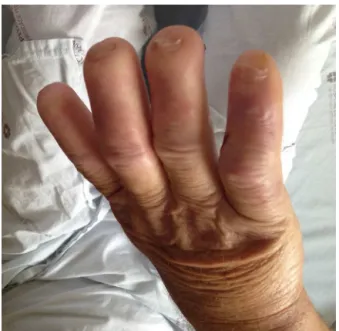r e v b r a s r e u m a t o l . 2017;57(6):630–632
ww w . r e u m a t o l o g i a . c o m . b r
REVISTA
BRASILEIRA
DE
REUMATOLOGIA
Case
report
Leprosy
simulating
systemic
sclerosis:
a
case
report
夽
Hanseníase
que
simula
esclerose
sistêmica:
relato
de
caso
Bruna
Burko
Rocha
Chu
a,∗,
Giorgina
Falcão
Brandão
Côrtes
Gobbo
a,
Rafaela
Copês
a,
Glênio
Gutjahr
a,
Erick
Cavalcanti
Cossa
a,
Eduardo
dos
Santos
Paiva
baUniversidadeFederaldoParaná(UFPR),HospitaldeClínicas,Curitiba,PR,Brazil
bUniversidadeFederaldoParaná(UFPR),HospitaldeClínicas,Servic¸odeReumatologia,Curitiba,PR,Brazil
a
r
t
i
c
l
e
i
n
f
o
Articlehistory:
Received23February2016 Accepted11August2016 Availableonline18October2016
Introduction
Leprosyisa chronic infectiousdisease caused by Mycobac-teriumleprae,beinghighlycontagiousbutwithlowmorbidity duetotheresistanceofagoodpartofthepopulationtothis disease.Itsworldwideprevalencehasdeclinedsincethe intro-ductionofmultidrugchemotherapy;butdespitethis,Brazil hasnotachievedthe goalofeliminatingthe disease,being secondonlytoIndiaintheabsolutenumberofcases.1Leprosy presentsabroadspectrumofclinicalmanifestationsandcan beadiagnosticchallenge,especiallyintheearlyyearsofthe disease.Someofthesemanifestationsresembletheclinical pictureofcertainrheumatologicdiseases.2,3Wereportacase ofleprosywithskinthickening,distalphalanxresorption,and facialtelangiectasia,simulatingsystemicsclerosis.
夽
StudyconductedatUniversidadeFederaldoParaná(UFPR),HospitaldeClínicas,Servic¸odeReumatologia,Curitiba,PR,Brazil. ∗ Correspondingauthor.
E-mail:brunabrchu@gmail.com(B.B.Chu).
Case
report
Male patient, 69 years, with clinical manifestations that started 4 years ago with sclerodactyly associated with an unrelated-to-coldcyanosisandpallorinhisextremities,with nohistoryofdigitalulceration,butwithprogressiveresorption ofdistalphalangesevidencedintheclinicalprogression.The patientstillhadsymptomsofsensitivepolyneuropathyinhis handsandfeetandtelangiectasiasontheface.Ayearbefore diagnosis,hypoesthesicskinlesionsonelbowsappeared.The patienthadnojointcomplaints,dyspneaordysphagia.There wasahistoryofintimatecontactwithafamilymemberwith ahistoryofleprosy6yearsbeforetheonsetofthepatient’s symptoms. A priorresearchforleprosy withaskin biopsy resultednegative.
http://dx.doi.org/10.1016/j.rbre.2016.09.010
rev bras reumatol.2017;57(6):630–632
631
Fig.1–Skinthickeningandresorptionofdistalphalanges.
Fig.2–Radiographyofthepatient’shandsshowing acro-osteolysis.
In the current evaluation, distal skin and ulnar nerve bilateral thickening, resorptionof distalphalanges (Fig. 1), telangiectasiason theface,aswell ashypoesthesiclesions withinfiltrationanderythemaonbothelbowswereevidenced. Laboratorytestswerenormalandaradiographyofhishands showed boneresorption ofdistal phalanges (Fig. 2). Capil-laroscopywasnotperformed.Thepatientunderwentanew biopsy,whichconfirmedthediagnosisoftuberculoidleprosy. Thepatientwasinstructedwithregardtosubsequent treat-mentand thathisclosecontactsshouldbeevaluated, and proceedswithhisdermatologicaltreatment.
Discussion
Leprosyresultsinseveralclinicalmanifestationsthatdepend onthehostimmuneresponse.Intuberculoidleprosy,there
is an efficient cell-mediated response, while lepromatous (Virchowian)leprosyischaracterizedbyhumoralimmunity. Betweenthesetwoextremes,intermediateformsareseenthat reflectthegradualvariationinresistanceagainstthebacillus.4 Intheearlystages,thepatientmaypresentwithonlyskin and neurological symptoms, showing no signs of involve-mentofotherorgans.2 Themusculoskeletalinvolvementis thethirdmostcommonsymptom.5Inastudyof70patients withleprosy,Vengadakrishnanetal.showedthat61.42%of patients showed rheumatological manifestations,the most commonofthembeingarthritis.6Ontheotherhand,a Brazil-ianstudyshowedthatonly6.1%of1257leprosypatientshad jointinvolvement.7
Systemic symptomsand thepresenceofautoantibodies canalsooccur.2Ribeiroetal.determinedtheantibodyprofile of158leprosypatients,withandwithoutjointinvolvement. Thefrequencyofanticardiolipinandanti-beta2glycoprotein Iantibodieswassignificantlyhigherinleprosypatients ver-sus healthy controls.8 Elbeialyet al.demonstrated that the presenceofanticardiolipinantibodieswasassociatedwiththe presenceofRaynaud’sphenomenoninpatientswithleprosy.9 Intheliterature,leprosycasesmisdiagnosedassystemic lupuserythematosus, vasculitis,rheumatoid arthritis,3 and systemic sclerosis have been described. The latter is an autoimmunedisorderthatcausesexcessiveaccumulationof collagen,causingskinsclerosisandfibrosisofinternalorgans. Leeetal.alsoreportedacaseofleprosysimulatingsystemic sclerosis.Thepatientwasmistakenlydiagnosedwiththis dis-ease, due tothe similarity ofskinlesions,the presenceof Raynaud’sphenomenon,andthepositivityofsome antibod-ies.Theskinthickening wassubsequently interpretedasa longstandingskinedemasecondarytoleprosyplates,andnot astruescleroderma.2
Initially,thepatientdescribedinthisstudywasdiagnosed asasystemicsclerosiscarrierbypresentingskinthickening in hishands, Raynaud’sphenomenon, telangiectasias, and resorptionofthedistalphalanges,andalsoduetothefact an initialskin biopsyhas notshownthe presenceof acid-fastbacilli.Resorptionofdistalphalanxoccursin20–25%of patientswithsystemicsclerosis,andthisfindingisstrongly associatedwithseveredigitalischemia,suggestingthatthisis duetoischemicatrophy.10Inleprosy,thechangesofthedistal phalanxcanbeofvarioustypes,forinstance,afocaldefect, irregularity, complete destruction,or concentricnarrowing, occurringin19–45%ofpatients.11
Despite severalsymptoms common tothesetwo condi-tionspresentedbyourpatient,wealsofoundanesthesiaof “Stocking-Glove”Pattern,andtheinvolvementofsignalsfrom otherorgans,asevidencedbytheabsenceofdysphagiaand dyspnea,andbypulmonaryfunctiontestswhichwerewithin thenormalrange.Thus,leprosywasshownasthemostlikely diagnosis,whichwasconfirmedbyanotherskinbiopsy.
632
rev bras reumatol.2017;57(6):630–632Conflicts
of
interest
Theauthorsdeclarenoconflictsofinterest.
r
e
f
e
r
e
n
c
e
s
1. LastóriaJC,deAbreuMAMM.Leprosy:reviewofthe epidemiological,clinical,andetiopathogenicaspects.Part1. AnBrasDermatol.2014;89:205–18.
2. LeeJY,ParkSE,ShinSJ,KimCW,KimSS.Caseoflepromatous leprosymisdiagnosedassystemicsclerosis.JDermatol. 2014;41:343–5.
3. RibeiroSLE,GuedesEL,PereiraHLA,SouzaLS.Manifestac¸ões sistêmicaseulcerac¸õescutâneasdahanseníase:diagnóstico diferencialcomoutrasdoenc¸asreumáticas.RevBras Reumatol.2009;49:623–6.
4. PereiraHLA,RibeiroSLE,SatoEI.Manifestac¸õesreumáticas dahanseníase.ActaReumatolPort.2008;33:407–14. 5. ChauhanS,WakhluA,AgarwalV.Arthritisinleprosy.
Rheumatology.2010;49:2237–42.
6.VengadakrishnanK,SaraswatPK,MathurPC.Astudyof rheumatologicalmanifestationsofleprosy.IndianJDermatol VenereolLeprol.2004;7:6–8.
7.PereiraHLA,RibeiroSLE,PenniniSN,SatoEI.Leprosy-related jointinvolvement.ClinRheumatol.2009;28:79–84.
8.RibeiroSLE,PereiraHLA,SilvaNP,SatoEI.Autoanticorposem pacientescomhanseníase,comesemcomprometimento articular,noEstadodoAmazonas.RevBrasReumatol. 2009;49:547–61.
9.ElbeialyA,Strassburger-LornaK,AtsumiT,BertolacciniML, AmengualO,HanafiM,etal.Antiphospholipidanti-bodiesin leproticpatients:acorrelationwithdiseasemanifestations. ClinExpRheumatol.2000;18:492–4.
10.JohnstoneEM,HutchinsonCE,VailA,ChevanceA,HerrickAL. Acro-osteolysisinsystemicsclerosisisassociatedwithdigital ischaemiaandseverecalcinosis.Rheumatology.
2012;51:2234–8.
